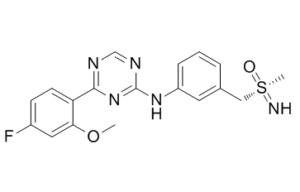This product is for research use only, not for human use. We do not sell to patients.

| Size | Price | Stock |
|---|---|---|
| 2mg | $250 | 3-6 Days |
| 5mg | $450 | 3-6 Days |
| 10mg | $700 | 3-6 Days |
| 25mg | $1150 | 3-6 Days |
| 50mg | $1750 | 3-6 Days |
| 100mg | $2850 | 3-6 Days |
Cat #: V3687 CAS #: 1414943-88-6 Purity ≥ 98%
Description: Atuveciclib (formerly known as BAY-1143572) is novel, potent, oral and highly selective PTEFb/CDK9 inhibitor with antitumor activity. It inhibits CDK9/CycT1 with an IC50 of 13 nM and is more than 100-fold more selective for CDK9 over CDK2. It also inhibits GSK3 kinase with IC50 values of 45 nM and 87 nM for GSK3α and GSK3β respectively. Atuveciclib is currently in Phase I clinical trial. Selective inhibition of exclusively transcription-regulating PTEFb/CDK9 is a promising new approach in cancer therapy. Starting from lead compound BAY-958, lead optimization efforts strictly focusing on kinase selectivity, physicochemical and DMPK properties finally led to the identification of the orally available clinical candidate atuveciclib (BAY 1143572). Structurally characterized by an unusual benzyl sulfoximine group, BAY 1143572 exhibited the best overall profile in vitro and in vivo, including high efficacy and good tolerability in xenograft models in mice and rats. BAY 1143572 is the first potent and highly selective PTEFb/CDK9 inhibitor to enter clinical trials for the treatment of cancer.
Publications Citing InvivoChem Products
Product Promise

- Physicochemical and Storage Information
- Protocol
- Related Biological Data
- Stock Solution Preparation
- Quality Control Documentation
| Molecular Weight (MW) | 387.43 |
|---|---|
| Molecular Formula | C18H18FN5O2S |
| CAS No. | 1414943-88-6 |
| Storage | -20℃ for 3 years in powder form |
| -80℃ for 2 years in solvent | |
| Solubility In Vitro | DMSO: >80 mg/mL |
| Water: <1mg/mL | |
| Ethanol:<1mg/mL | |
| Synonyms | BAY1143572; BAY 1143572; BAY-1143572 |
| Protocol | In Vitro | In vitro activity: Atuveciclib (formerly known as BAY-1143572) is novel, potent, oral and highly selective PTEFb/CDK9 inhibitor. It inhibits CDK9/CycT1 with an IC50 of 13 nM and is more than 100-fold more selective for CDK9 over CDK2. It also inhibits GSK3 kinase with IC50 values of 45 nM and 87 nM for GSK3α and GSK3β respectively. Atuveciclib is currently in Phase I clinical trial. Kinase Assay: Atuveciclib (formerly known as BAY-1143572) is novel, potent, oral and highly selective PTEFb/CDK9 inhibitor. It inhibits CDK9/CycT1 with an IC50 of 13 nM and is more than 100-fold more selective for CDK9 over CDK2. It also inhibits GSK3 kinase with IC50 values of 45 nM and 87 nM for GSK3α and GSK3β respectively. Cell Assay: BAY 1143572 demonstrates antiproliferative activity against HeLa cells (IC50 = 920 nM) and MOLM-13 cells (IC50 = 310 nM). It also demonstrates improved Caco-2 permeability and a decreased efflux ratio (PappA→B: 35 nm/s, ER: 6) relative to lead compound BAY‐958 (PappA→B: 22 nm/s, ER: 15). |
|---|---|---|
| In Vivo | In an in vivo pharmacokinetic study in rats, BAY 1143572 showed low blood clearance (CLb 1.1 L/h/kg). The volumes of distribution (V ss) of BAY 1143572 is 1.0 L/kg. BAY 1143572 shows significantly improved oral bioavailability of 54 %. The blood/plasma ratios is about 1. It does not show significant inhibition of cytochrome P450 activity, with IC50 values >20 μM. The administration of BAY 1143572 in immunocompromized NOD/Shi-scid/IL-2Rγ null (NOG) mice xenografted with patient-derived ATL cells greatly reduced the infiltration of ATL cells into organs, such as liver and bone marrow. Decreased human soluble IL2R levels in serum were also observed, which indicated a reduction of ATL tumor burden. | |
| Animal model | Immunocompromized NOD/Shi-scid/IL-2Rγ null (NOG) mice xenografted with patient-derived ATL cells and in vivo pharmacokinetic in rats |
| Solvent volume to be added | Mass (the weight of a compound) | |||
|---|---|---|---|---|
| Mother liquor concentration | 1mg | 5mg | 10mg | 20mg |
| 1mM | 2.5811 mL | 12.9056 mL | 25.8111 mL | 51.6222 mL |
| 5mM | 0.5162 mL | 2.5811 mL | 5.1622 mL | 10.3244 mL |
| 10mM | 0.2581 mL | 1.2906 mL | 2.5811 mL | 5.1622 mL |
| 20mM | 0.1291 mL | 0.6453 mL | 1.2906 mL | 2.5811 mL |
This equation is commonly abbreviated as: C1 V1 = C2 V2
- (1) Please be sure that the solution is clear before the addition of next solvent. Dissolution methods like vortex, ultrasound or warming and heat may be used to aid dissolving.
- (2) Be sure to add the solvent(s) in order.




































